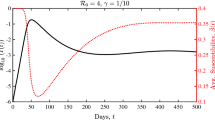Abstract.
Empirical evidence shows that childhood diseases persist in large communities whereas in smaller communities the epidemic goes extinct (and is later reintroduced by immigration). The present paper treats a stochastic model describing the spread of an infectious disease giving life-long immunity, in a community where individuals die and new individuals are born. The time to extinction of the disease starting in quasi-stationarity (conditional on non-extinction) is exponentially distributed. As the population size grows the epidemic process converges to a diffusion process. Properties of the limiting diffusion are used to obtain an approximate expression for τ, the mean-parameter in the exponential distribution of the time to extinction for the finite population. The expression is used to study how τ depends on the community size but also on certain properties of the disease/community: the basic reproduction number and the means and variances of the latency period, infectious period and life-length. Effects of introducing a vaccination program are also discussed as is the notion of the critical community size, defined as the size which distinguishes between the two qualitatively different behaviours.
Similar content being viewed by others
Author information
Authors and Affiliations
Additional information
Received: 14 February 2000 / Revised version: 5 June 2000 / Published online: 24 November 2000
Rights and permissions
About this article
Cite this article
Andersson, H., Britton, T. Stochastic epidemics in dynamic populations: quasi-stationarity and extinction. J Math Biol 41, 559–580 (2000). https://doi.org/10.1007/s002850000060
Issue Date:
DOI: https://doi.org/10.1007/s002850000060




